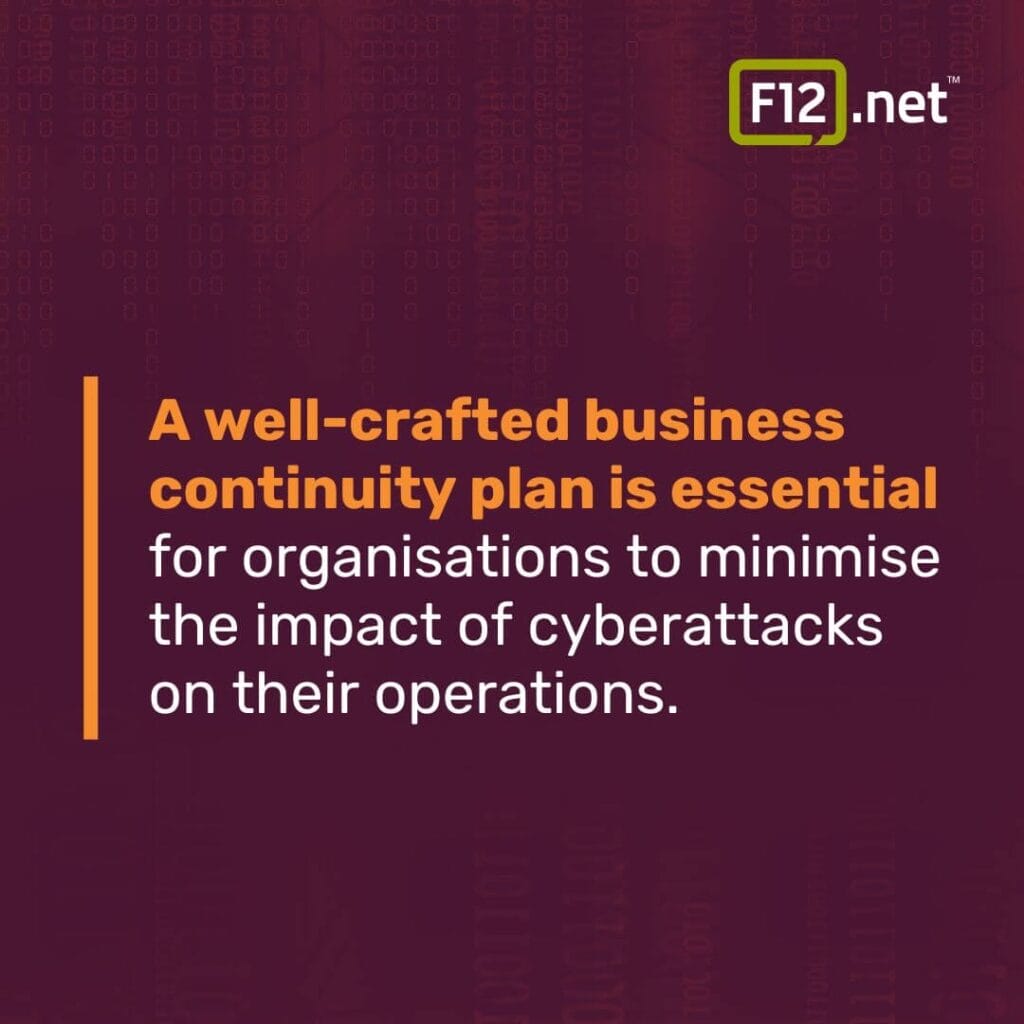Brief: Knowledge is power. Learn about the evolution of cyber security threats, including ransomware, AI-driven attacks, and IoT vulnerabilities. Learn strategies for business continuity, customer trust, and adapting to future challenges with proactive and zero-trust security measures.
“Okay. I WANT to comply. I just find the order of those threats very confusing.” – Guy, Free Guy
This quote captures the confusion many businesses experience when dealing with today’s sophisticated cyber security threats.
Cyber security threats, including ransomware, deepfakes, and IoT vulnerabilities, are now more prevalent and sophisticated, posing significant risks to businesses and undermining customer trust.
Why is this important?
The financial and operational consequences of cyberattacks can be severe.
For example, the 2021 Kaseya ransomware attack disrupted numerous businesses by encrypting data and demanding millions in ransom, leading to significant operational setbacks and a loss of customer trust.
The broader impact is equally alarming.
In 2023, the average cost of a data breach reached $4.45 million. Additionally, 83% of organisations have faced multiple data breaches, emphasising the ongoing nature of these threats. And 60% of small businesses that suffer a cyberattack close within just 6 months.
These figures highlight that the consequences of cyberattacks extend beyond immediate disruptions—they can threaten the very survival of a business.
To address these risks, businesses must adopt comprehensive cyber security strategies. This includes developing strong incident response plans, investing in AI-driven threat detection, and maintaining transparent communication with customers.
Regularly updating security practices and staying informed about emerging threats are essential steps to protect against these disruptions and maintain trust.
In this article, we’ll explore the latest cyber security threats, their impact on businesses and customer trust, and actionable strategies for reducing risk and building resilience in the face of future challenges.
Let’s get started!

Emerging Cyber Security Threats: Staying Ahead
- Ransomware attacks target critical infrastructure and businesses
- AI automates and personalises cyber attacks
- IoT and 5G vulnerabilities expand the attack surface
Ransomware attacks have become more sophisticated, targeting critical infrastructure and businesses with increased frequency.
Attackers employ double extortion tactics, encrypting data and threatening to leak sensitive information if ransom demands are not met.
To prevent ransomware attacks, organisations must implement regular data backups, provide employee cyber security training, and develop comprehensive incident response plans.
Ransomware Attacks on the Rise
Ransomware attacks have continued to plague businesses throughout 2024. In January, Change Healthcare provider fell victim to a ransomware attack that encrypted patient records and disrupted operations for weeks.
The attackers demanded a multi-million dollar ransom, ultimately forcing the provider to pay to restore access to critical data. According to a report by Cyber Security Ventures, ransomware attacks are projected to cost organisations around $265 billion by 2031.

Sophisticated Ransomware Targeting Critical Infrastructure
In March, a ransomware group targeted a national power grid, causing widespread outages and economic disruption.
The attack highlighted the growing threat to critical infrastructure, as cyber criminals increasingly focus on high-value targets with the potential for significant societal impact.
A study by Statista found that 72% of organisations experienced a ransomware attack in 2023.
AI-Powered Cyber Attacks
The use of artificial intelligence in cyber attacks has grown significantly in 2024. In May, researchers discovered a new malware strain that utilised AI to personalise phishing emails, increasing the likelihood of successful compromise.
The malware analysed victims’ social media profiles and online behavior to craft highly convincing messages.
Deepfakes and Social Engineering Powered by AI
In August, a major corporation fell victim to a deepfake-based social engineering attack. Attackers used AI to generate a convincing video of the company’s CEO, tricking employees into transferring funds to a fraudulent account.
The incident represents the need for advanced AI-driven threat detection and adaptive security systems to counter these evolving threats.
IoT and 5G Vulnerabilities
The rapid growth of IoT devices and 5G networks has expanded the attack surface for cybercriminals. In September, a botnet compromised millions of insecure IoT devices, launching massive DDoS attacks against online services.
The attacks caused widespread disruption and highlighted the importance of secure device configuration and regular firmware updates. According to a report by Statista, the number of IoT devices is projected to reach 30.9 billion by 2025.
Insecure IoT Devices as Entry Points for Attackers
In November, a hacking group exploited vulnerabilities in smart home devices to gain access to corporate networks. The attackers used the compromised devices as a foothold to move laterally within the network, stealing sensitive data and installing ransomware.
This incident emphasised the need for strong network segmentation and monitoring to detect and contain threats originating from IoT devices. A study by IoT For All found that 75% of IoT devices contain critical vulnerabilities, making them attractive targets for cybercriminals.
As we move into 2025, organisations must remain vigilant and proactive in the face of these changing cyber security threats. Investing in employee training, implementing multi-factor authentication, and leveraging AI-driven security solutions will be critical to staying ahead.
By adopting a risk-based approach to cyber security and creating a culture of security awareness, businesses can mitigate the impact of cyberattacks and maintain the trust of their customers.
Mitigating the Impact of Cyberattacks on Business Continuity
- Develop a comprehensive business continuity plan to minimise disruptions
- Invest in strong incident response capabilities for swift threat containment
- Prioritise employee awareness and training to reduce human error risks
Develop a Comprehensive Business Continuity Plan
A well-crafted business continuity plan is essential for organisations to minimise the impact of cyberattacks on their operations.
The first step is to identify critical assets, processes, and dependencies that are vital to the organisation’s functioning. This includes systems, data, and personnel that are indispensable for maintaining business operations.
Next, clearly define roles and responsibilities for key personnel during a cyberattack. This ensures a coordinated response and minimises confusion amidst the chaos. Regularly testing and updating the plan based on emerging threats is crucial to maintain its effectiveness.

Key Components of a Business Continuity Plan
- Risk assessment and prioritisation
- Incident response procedures
- Communication protocols
- Recovery time objectives (RTO) and recovery point objectives (RPO)
- Regular testing and updates
Invest in Strong Incident Response Capabilities
Having a dedicated incident response team is crucial for swift containment and recovery from cyberattacks. This team should consist of experts from various domains, including IT, security, legal, and public relations.
Implementing automated threat detection and response tools can significantly reduce the time taken to identify and contain threats. These tools use machine learning and artificial intelligence to analyse network traffic and system logs for anomalies indicative of an attack.
Conducting regular incident response drills and post-incident reviews helps fine-tune the response procedures and identifies areas for improvement. It also helps the team stay prepared for real-world scenarios.
Essential Incident Response Steps
- Preparation
- Detection and analysis
- Containment
- Eradication
- Recovery
- Lessons learned
Prioritise Employee Awareness and Training
Employees are often the weakest link in an organisation’s cyber security defences. Providing regular cyber security training to all employees is essential to reduce the risk of human error leading to a successful cyberattack.
Simulating phishing and social engineering attacks helps test employee awareness and identifies individuals who may need additional training. Encouraging a culture of cyber security vigilance and reporting helps catch potential threats early.
Key Topics to Cover in Cyber Security Training
- Identifying and reporting phishing attempts
- Strong password practices
- Safe browsing habits
- Handling sensitive data
- Physical security measures
Implement Multi-Layered Security Controls
No single security control is foolproof against all threats. Implementing a multi-layered approach, also known as defence-in-depth, helps mitigate the impact of a successful attack.
This includes a combination of preventive, detective, and corrective controls at various levels, such as network segmentation, access controls, encryption, and monitoring. Regularly reviewing and updating these controls is crucial.
Develop a Strong Backup and Recovery Strategy
Having reliable backups is essential for quick recovery from a cyberattack. Implement a 3-2-1 backup strategy – keep at least three copies of data, on two different media, with one copy offsite.
Regularly test the backups to ensure they are recoverable and meet the defined RTOs and RPOs. Consider using immutable backups or air-gapped storage to protect against ransomware attacks.
By implementing these measures, organisations can significantly reduce the impact of cyberattacks on their business continuity. However, it’s essential to remember that cyber security is an ongoing process that requires continuous monitoring, improvement, and adaptation to stay ahead.
Maintaining Customer Trust Amidst Evolving Cyber Threats
- Build trust through transparency, data protection, and proactive security
- Invest in advanced security technologies and collaborate with industry partners
- Regularly communicate with customers and offer support during incidents
Transparency and Timely Communication
Businesses must prioritise open and honest communication with their customers. When a data breach or security incident occurs, it’s crucial to notify affected customers promptly.
Provide clear details about the nature of the incident, the extent of the data compromise, and the steps being taken to resolve the issue. Offer resources and support to help customers protect their information and mitigate potential consequences.
Transparency builds trust and shows that the company takes responsibility for its actions. A study by PwC found that 87% of consumers are willing to take their business elsewhere if they don’t trust a company’s data practices.
By being forthcoming about security incidents and demonstrating a commitment to resolving them, businesses can maintain customer loyalty even in challenging times.

Best Practices for Incident Communication
- Establish a clear communication plan that outlines roles, responsibilities, and channels for sharing information during a security incident.
- Use plain language in customer notifications, avoiding technical jargon that may confuse or alienate them.
- Provide regular updates on the progress of the investigation and remediation efforts.
- Offer a dedicated support line or email address for customers to ask questions and voice concerns.
Demonstrating a Commitment to Data Protection
To maintain customer trust, businesses must show that they take data protection seriously. This involves implementing strong security measures like data encryption, access controls, and multi-factor authentication.
Adhering to industry standards and regulations, such as GDPR for European customers or HIPAA for healthcare data, demonstrates a commitment to privacy and security.
Regular audits of data practices help identify areas for improvement and ensure that security measures remain effective against threats. Engaging third-party security firms to conduct assessments can provide an objective evaluation of a company’s data protection practices.
The Importance of Employee Training
Data protection isn’t just about technology; it also requires a culture of security within the organisation.
Investing in employee training programs on data handling, privacy, and security best practices is essential.
Regular training sessions, coupled with phishing simulations and other awareness initiatives, help employees recognise potential threats and understand their role in protecting customer data.
When everyone in the organisation is committed to data protection, it builds a strong foundation for maintaining customer trust.
Building Trust Through Proactive Security Measures
In addition to reacting effectively when incidents occur, businesses can build customer trust by taking a proactive approach to cyber security.
This involves conducting regular vulnerability assessments and penetration testing to identify and address potential weaknesses before attackers can exploit them.
Investing in advanced security technologies, such as AI-driven threat detection and automated incident response, helps businesses stay ahead of evolving threats.
These tools can analyse vast amounts of data to identify anomalies and potential attacks in real-time, allowing security teams to respond quickly and minimise damage.
Collaborating with industry partners and sharing threat intelligence is another proactive measure that benefits both businesses and their customers.
By working together to identify emerging threats and develop collective defence strategies, companies can better protect their own data and contribute to a more secure ecosystem overall.
The Role of Transparency in Proactive Security
While some businesses may be hesitant to share details about their security practices, transparency can actually build trust with customers.
Providing information about the steps being taken to protect data, the technologies being used, and the company’s commitment to continuous improvement shows customers that security is a top priority.
Consider publishing a security whitepaper or including information about security practices on the company website. Highlight any certifications or audits that demonstrate a commitment to data protection.
By being open about security efforts, businesses can differentiate themselves and build trust with customers who are increasingly concerned about the safety of their data.
Empowering Customers to Protect Themselves
Finally, businesses can maintain trust by empowering customers to take an active role in protecting their own data. This involves providing educational resources and tools to help customers understand potential threats and take steps to secure their accounts and devices.
For example, businesses can offer guidance on creating strong passwords, enabling two-factor authentication, and recognising phishing attempts.
They can also provide customers with options to control their data, such as the ability to review and delete personal information or opt-out of data collection for certain purposes.
By giving customers more control and knowledge, businesses demonstrate respect for their privacy and help create a partnership in data protection. This builds trust and helps create a more resilient security ecosystem overall.
The Benefits of Customer Education
Investing in customer education not only helps protect individual accounts but also reduces the risk of successful attacks on the business as a whole.
When customers are better informed about security best practices, they are less likely to fall victim to phishing scams or other tactics that could compromise business data.
Furthermore, educated customers are more likely to appreciate and trust a company’s security efforts. They understand the challenges of protecting data and are more forgiving if incidents do occur, as long as the company is transparent and responsive in its handling of the situation.
The Importance of Maintaining Trust
Maintaining customer trust is more important than ever. A single data breach can damage a company’s reputation and lead to lost business, legal liabilities, and significant financial costs.
By prioritising transparency, data protection, proactive security measures, and customer empowerment, businesses can build resilience and maintain the trust of their customers even in the face of threats. This trust is essential for long-term success and growth.
The role of a content editor involves ensuring that content is clear, concise, and effective in conveying its message.
This includes tasks such as:
- Clarifying the structure and coherence of the text
- Ensuring that documentation of sources is complete and formatted correctly
- Querying the author if facts are found to be inconsistent or suspected to be wrong
- Applying house style to ensure consistency
- Correcting misspellings, punctuation, and grammatical errors
- Pointing out and suggesting ways to correct faulty parallelism, wordiness, and repetition.
In contrast, a copy editor focuses on the detailed, technical aspects of the content, such as:
- Ensuring the accuracy of names, dates, and facts
- Verifying the spelling of proper nouns
- Fact-checking and proofreading for typographical errors and inconsistencies
- Maintaining a style sheet for consistency in formatting and style.
In the context of the provided blog section, the role of a copyeditor would involve:
- Fact-checking statistics and figures, such as the effectiveness of multi-factor authentication and the reduction in the average cost of a data breach
- Verifying the accuracy of sources cited, such as the report by Capgemini and the NIST Cyber Security Framework
- Ensuring consistency in formatting and style throughout the content
- Correcting any grammatical or typographical errors
- Providing inline references with full links to the original sources.
The Evolution of cyber security Threats: A Historical Perspective
- Cyber security threats have evolved from simple, disruptive malware to sophisticated, targeted attacks
- The rise of organised cybercrime and state-sponsored attacks has led to more complex threats
- Advanced persistent threats and data breaches have become a significant concern for businesses
Early Days of Cyber Security: Viruses and Worms
Cyber security threats primarily consisted of viruses and worms. These self-replicating malware programs were designed to spread quickly and cause disruption to computer systems.
The Morris worm, released in 1988, was one of the first known internet worms and infected approximately 10% of the 60,000 computers connected to the internet at the time.
Another notable example is the ILOVEYOU virus, which spread via email in 2000 and caused an estimated $10 billion in damages worldwide.
To combat these early threats, antivirus software and user awareness campaigns were the primary countermeasures. Antivirus programs scanned computer systems for known malware signatures and quarantined or removed any detected threats.
User education focused on teaching individuals not to open suspicious email attachments or download files from untrusted sources.
The Impact of Early Cyber Security Threats on Businesses
While early viruses and worms were disruptive, their impact on businesses was relatively limited compared to modern threats. However, these incidents highlighted the need for organisations to invest in cyber security measures and develop incident response plans.
Companies began to recognise the importance of regularly updating their antivirus software and educating their employees about safe computing practices.
Rise of Organised Cybercrime and Targeted Attacks
As the internet grew and became more integral to business operations, cybercriminals saw an opportunity to profit from their malicious activities.
Organised cybercrime groups emerged, developing more sophisticated malware and targeting specific industries or organisations for financial gain.
The Zeus Trojan, which first appeared in 2007, was a prime example of this shift. Zeus was designed to steal banking credentials and facilitate unauthorised transfers, and it quickly became a favorite tool among cybercriminals.
In addition to financially motivated attacks, state-sponsored cyber attacks also became more prevalent during this period. The Stuxnet worm, discovered in 2010, was a highly sophisticated malware program designed to target industrial control systems.
It was believed to have been developed by nation-states to sabotage Iran’s nuclear program, highlighting the growing use of cyber weapons in geopolitical conflicts.
To defend against these more advanced threats, organisations began deploying firewalls, intrusion detection systems (IDS), and threat intelligence platforms.
Firewalls helped control network traffic and block unauthorised access, while IDS monitored networks for suspicious activity.
Threat intelligence services provided organisations with up-to-date information on emerging threats and utilising a vulnerability management system, allowing them to proactively defend their systems.
Advanced Persistent Threats and Data Breaches
In recent years, cyber security threats have become even more complex and difficult to detect. Advanced persistent threats (APTs) are highly targeted, long-term attacks that aim to infiltrate networks and steal sensitive data without being discovered.
These attacks often employ a combination of social engineering, zero-day vulnerabilities, and custom malware to evade traditional security measures.
One of the most notable examples of an APT is the SolarWinds supply chain attack, which was discovered in 2020. The attackers compromised the software update process of the SolarWinds Orion platform, allowing them to distribute malware to thousands of organisations worldwide.
The attack went undetected for months, highlighting the difficulty in detecting and defending against sophisticated APTs.
Data breaches have also become a significant concern for businesses, as the theft of sensitive customer or employee information can result in significant financial losses and reputational damage.
The Target data breach in 2013, which exposed the personal information of over 110 million customers, serves as a stark reminder of the consequences of inadequate cyber security measures.
To combat these evolving threats, organisations are adopting more advanced security solutions, such as endpoint detection and response (EDR), threat hunting, and zero-trust security frameworks.
EDR solutions continuously monitor endpoints for signs of compromise and provide incident response capabilities. Threat hunting involves proactively searching for hidden threats that may have evaded detection.
Zero-trust security operates on the principle of “never trust, always verify,” requiring strict identity verification and access controls for all users and devices.
The Importance of Continuous Adaptation in Cyber Security
As cyber security threats continue to evolve, it is essential for businesses to maintain a proactive and adaptive approach to their security strategies.
This involves regularly reassessing their risk, investing in advanced security technologies, and creating a culture of security awareness among employees.
Organisations should also prioritise collaboration and information sharing within their industries to stay informed about emerging threats and emerging technologies.
Engaging with cyber security experts, attending conferences, and participating in threat intelligence sharing communities can help businesses.
What is Cyber Security and Why It Matters
TL;DR:
- Cyber security protects digital assets from unauthorised access and attacks
- It’s crucial for businesses, governments, and individuals
- A comprehensive cyber security program includes technical, administrative, and physical controls
Defining Cyber Security
Cyber security is the practice of protecting computer systems, networks, and data from unauthorised access, attacks, or damage. The primary goal of cyber security is to ensure the confidentiality, integrity, and availability of information assets.
This means that data should be accessible only to authorised users (confidentiality), remain accurate and untampered (integrity), and be available when needed (availability).
Cyber security is applicable to individuals, businesses, and governments alike. For individuals, it means protecting personal information, such as financial data, from theft or misuse.
Businesses must safeguard their proprietary information, customer data, and intellectual property. Governments need to secure sensitive information related to national security and critical infrastructure.
The Growing Importance of Cyber Security
Our reliance on technology has made cyber security more critical than ever. As more businesses adopt digital technologies and store sensitive data online, the potential for cyber attacks and data breaches has increased significantly.
The costs and consequences of such incidents can be severe, including financial losses, reputational damage, and legal liabilities.
According to a report by CyberCrime Magazine, the global cost of cybercrime is expected to reach $10.5 trillion annually by 2025, up from $3 trillion in 2015. This figure highlights the growing need for cyber security measures.
Moreover, businesses must comply with various legal and regulatory requirements related to data protection, such as the General Data Protection Regulation (GDPR) in the European Union and the California Consumer Privacy Act (CCPA) in the United States.
Failure to meet these requirements can result in hefty fines and legal consequences.
Key Elements of a Comprehensive Cyber Security Program
To effectively protect against cyber threats, organisations must implement a comprehensive cyber security program that includes three key elements:
Technical Controls
Technical controls are the foundation of any cyber security program. These include:
- Firewalls: Network security devices that monitor and control incoming and outgoing network traffic based on predetermined security rules.
- Antivirus and anti-malware software: Tools that detect, prevent, and remove malicious software from computer systems.
- Encryption: The process of converting data into a code to prevent unauthorised access.
- Access controls: Mechanisms that limit access to systems and data based on user roles and permissions.
Administrative Controls
Administrative controls are policies, procedures, and guidelines that govern how an organisation’s employees and systems operate.
These include:
- Security policies: Documented rules and procedures that define an organisation’s approach to cyber security.
- Employee training: Regular training sessions to educate employees about cyber threats and best practices for maintaining security.
- Incident response plans: Step-by-step guides for detecting, responding to, and recovering from cyber incidents.
Physical Controls
Physical controls are measures that protect an organisation’s physical assets, such as data centres and computer hardware.
These include:
- Secure data centres: Facilities designed to protect servers and other computing equipment from unauthorised access and environmental hazards.
- Access restrictions: Measures that limit physical access to sensitive areas, such as server rooms, to authorised personnel only.
- Environmental protections: Systems that maintain optimal temperature, humidity, and air quality to prevent damage to computing equipment.
Cyber security is a critical aspect of modern life that affects individuals, businesses, and governments alike.
As cyber threats continue to evolve and increase in sophistication, it is essential to implement a comprehensive cyber security program that includes technical, administrative, and physical controls.
By understanding the importance of cyber security and taking proactive steps to protect digital assets, organisations can mitigate the risks of cyber attacks and data breaches, while maintaining the trust of their customers and stakeholders.
Embracing the Future of Cyber Security
With new threats emerging and old ones becoming more sophisticated.
In 2024, businesses face ransomware attacks, AI-powered cyber threats, and vulnerabilities in IoT and 5G networks.
To stay ahead, companies must develop comprehensive business continuity plans, invest in incident response capabilities, and prioritise employee awareness and training.
Maintaining customer trust is crucial in the face of evolving cyber threats. Transparency, timely communication, and a commitment to data protection are essential.
By demonstrating proactive security measures and collaborating with industry partners, businesses can build trust and create long-lasting relationships with their customers.
As we look to the future, adapting cyber security strategies is key.
Embracing a zero-trust security model, leveraging AI and machine learning for proactive defence, and creating a culture of continuous improvement.
How is your organisation preparing for the cyber security challenges of the future?
Take the first step today by assessing your current security and identifying areas for improvement. By staying vigilant, adaptable, and committed to protecting your business and customers, you can thrive in the face of cyber threats.



